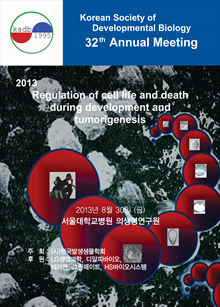간행물
한국발생생물학회 학술대회논문집

- 발행기관 한국발생생물학회
- 자료유형 학술대회
- 간기 연간
- 수록기간 1998 ~ 2017
- 주제분류 자연과학 > 생물학 자연과학 분류의 다른 간행물
- 십진분류KDC 472DDC 570
권호리스트/논문검색
한국발생생물학회 2001년도 전기 제11차 학술대회 논문집 (2001년 3월) 18건
1.
2001.03
서비스 종료(열람 제한)
2.
2001.03
서비스 종료(열람 제한)
3.
2001.03
서비스 종료(열람 제한)
4.
2001.03
서비스 종료(열람 제한)
5.
2001.03
서비스 종료(열람 제한)
This study examined the extent of mammary excretion and placental transfer of bisphenol A in rats. Bisphenol A was given by simultaneous i.v. bolus injection plus infusion to steady-state at low, medium and high doses. The steady-state serum levels of bisphenol A were linearly increased with increasing the dosing rate. The systemic clearance (mean range, 119.2-154.1 ml/min/kg) remained unaltered over the dosing rate studied. The levels of bisphenol A in milk exceeded those in serum, with the steady-state milk to serum concentration ratio being 2.4-2.7. The steady-state milk levels of bisphenol A were also increased linearly with increasing the infusion rate. In a separate study, the kinetic disposition of bisphenol A in the rat maternal-fetal unit was studied in pregnant rats. After i.v. injection, bisphenol A concentration in the maternal serum declined biexponentially. Bisphenol A was rapidly distributed into placenta, fetus and amniotic fluid, with maximum concentrations in these tissues achieved within 1 hr of injection. The decline of bisphenol A in placenta, fetus and amniotic fluid paralleled that of maternal serum. A simultaneous computer simulation showed that the observed concentrations were well represented by a 5-compartmental model consisting of the maternal central, placenta, fetus, amniotic fluid, and maternal tissue compartments.
6.
2001.03
서비스 종료(열람 제한)
7.
2001.03
서비스 종료(열람 제한)
8.
2001.03
서비스 종료(열람 제한)
9.
2001.03
서비스 종료(열람 제한)
10.
2001.03
서비스 종료(열람 제한)
R. Philippinarum is dioecious and oviparous. In the early vitellogenic oocyte, the Golgi apparatus and mitochondria present in the perinuclear region are involved in the formation of lipid droplets and in lipid granule formation. In the late vitellogenic oocyte, the endoplasmic reticulum, mitochondria in the cytoplasm are involved in the formation of proteid yolk granules. At this time, exogenous lipid granular substance and glycogen particles in the germinal epithelium are passed into the ooplasm of oocyte through the microvilli of the vitelline envelope. Ripe oocytes are about 55-60 m in diameter. The spawning period was once a year between early June and early October, and the main spawning occurred between July and August when seawater temperature was approximately 20 C. The reproductive cycle of this species can be categorized into five successive stages: early active stage (February to March), late active stage (April to May), ripe stage (April to August), partially spawned stage (June to October), and spent/inactive stage (August to March). Gonad developmental phases by histological qualitative analysis showed similar results with those of quantitative image analysis.
11.
2001.03
서비스 종료(열람 제한)
In ultrastructure study of testis, Sertoli cells start to differentiate at 16 days of gestation. Transcripts of FSH receptor, IGF-I receptor, ER receptor and androgen receptor were highly and initially expressed at 16 day of gestation. As results of in situ PCR at 16 day of gestation, transcripts of FSH, IGF-I receptor were detected in Sertoli cells and spermatogonia, whereas the receptors of and androgen were detected in Sertoli cells. Therefore, expression of FSH and estrogen androgen, IGF-I and could play an important role during fetal and prepubertal testicular development by stage specific manner in mouse.
12.
2001.03
서비스 종료(열람 제한)
13.
2001.03
서비스 종료(열람 제한)
Gelatin zymograms of bFF and bS showed GA110 and 62 kDa gelatinses in adsition to several minor ones. Of these, GA110 gelatinase was abolished by treating bFF or bS with bOF and interestingly, its enzymatic activity was enhanced by adding EDTA to bFF or bS before zymographic analyses. Experiments using specific inhibitors of MMPs indicated that GA110 and 62 kDa proteins were indeed gelatinases. Immunoblotting experiments using an antibody against human MMP-2 showed that both GA110 and 62 kDa were an MMP-2 isoform and active MMP-2, respectively. The results suggest that the interaction between bFF and bOF can occur at the time of fertilization.
14.
2001.03
서비스 종료(열람 제한)
15.
2001.03
서비스 종료(열람 제한)
16.
2001.03
서비스 종료(열람 제한)
17.
2001.03
서비스 종료(열람 제한)

